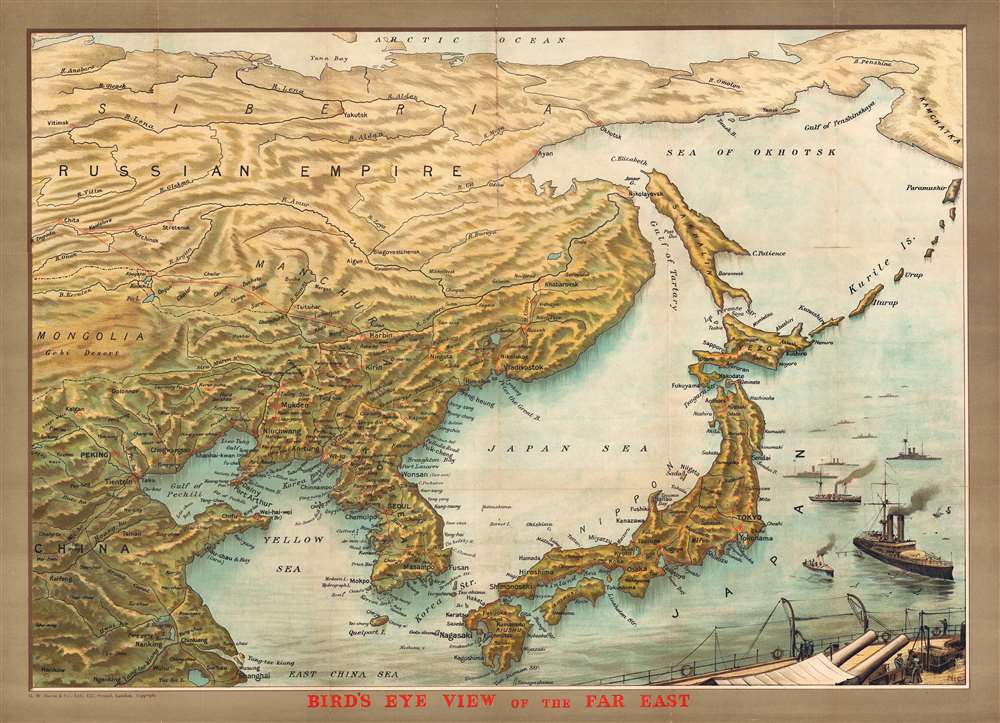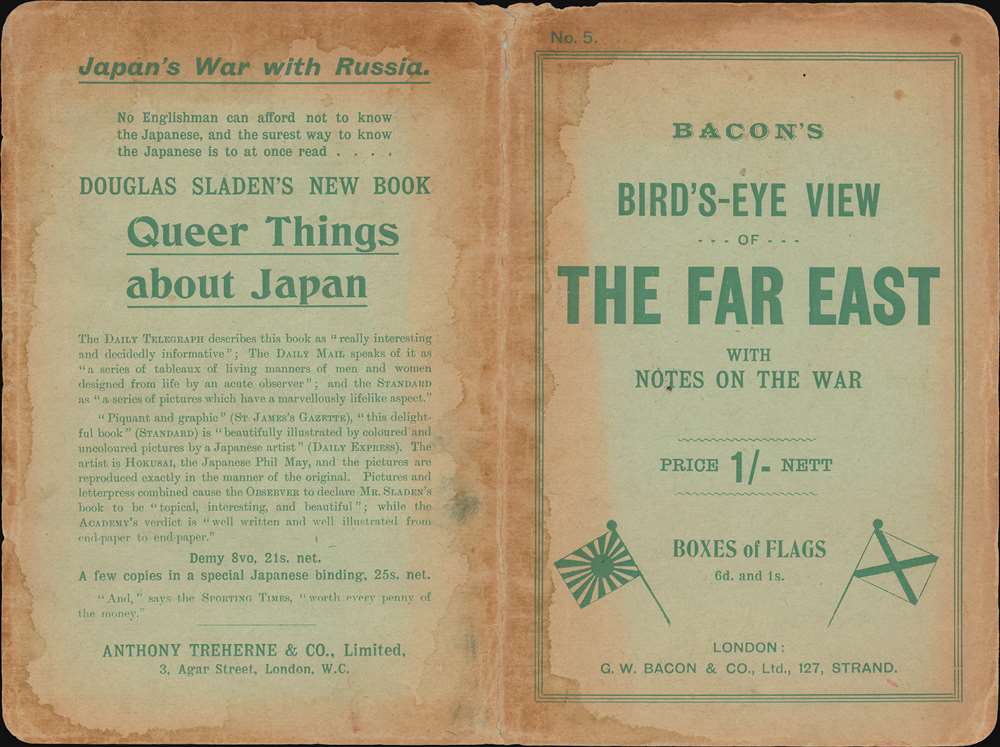1904 Bacon Bird's'Eye View of the Russo-Japanese War (China, Japan, Korea)
RussoJapaneseWar-bacon-1904
Title
1904 (undated) 20.75 x 28.75 in (52.705 x 73.025 cm)
Description
Russo-Japanese War
The Russo-Japanese War, fought from February 8, 1904 - September 5, 1905, pitted Imperial Japan against Tsarist Russia over rival imperial ambitions in Manchuria and Korea. Both Russia and Japan had grand visions for the region. Russia traditionally had only one Pacific port, Vladivostok, which was operational only during the warm summer months. In 1898, Russia coerced China, then weakened after the First Sino-Japanese War (1894 - 1895), to lease Port Arthur, a warm water port on the Liaodang Peninsula. They also negotiated a right-of-way to connect Port Arthur to the China Eastern Railway, which ran from nearby Dalian (Dalny) to Harbin, a stop on the Siberian Railway. Russia, eager to expand southwards from Siberia, considered Port Arthur the cornerstone of a sphere of influence covering China, Manchuria, and Korea. Japan had its own Imperial ambitions and saw itself as the natural overlord in East Asia. Korea and Manchuria in particular were important as steppingstones into China, with its seemly unlimited resources.There was initially some attempt at negotiation between the imperialist powers, but Tsar Nicholas II arrogantly believed it impossible that Japan could challenge a major European power. Japan proved him wrong, launching a surprise attack on the Russian Eastern Fleet stationed at Port Arthur. Throughout the course of the war, the Russians were defeated again and again, humiliating the Tsar and forcing U.S. President Theodore Roosevelt to arbitrate a peace, confirmed by the Treaty of Portsmouth. The treaty recognized Japan's claims on Korea and called for the evacuation of Russian forces from Manchuria, including from Port Arthur.
The overwhelming victory of Imperial Japan came as a surprise to international observers, being the first major military victory in the modern era of an Asian over European power. The consequences transformed the balance of power, confirmed Japan as the pre-eminent power in East Asia.
Pro-Japanese Text
The map accompanied a small booklet with a pro-Japanese anti-Russian perspective on the war situation in East Asia that reads like the billboard of a Humphrey Bogart move,'The blast of war blows in our ears.' Very soon in the 'Lan of the Morning Calm' the angle of death will be abroad, and red and widespread ruin will be the result. Russian and japan have unsheathed their swords, and a struggle is being entered upon, the end of which no man can foresee.The author goes on to laud Japanese honor and integrity, if in a Euro-centric racist way, writing 'though not professedly Christian, [Japan] has shown a correctness of conduct and a forbearance which might well put to the blush many nations with centuries of civilization behind them.' In general, the Japanese were viewed in England as the better and more reasonable of the two powers - not the threat to most western powers that Russia had historically been, nor a mere pushover.
Chromolithography
Chromolithography is a color lithographic technique developed in the mid-19th century. The process involved using multiple lithographic stones, one for each color, to yield a rich composite effect. Oftentimes, the process would start with a black basecoat upon which subsequent colors were layered. Some chromolithographs used 30 or more separate lithographic stones to achieve the desired product. Chromolithograph color could also be effectively blended for even more dramatic results. The process became extremely popular in the late 19th and early 20th centuries, when it emerged as the dominate method of color printing. The vivid color chromolithography produced made it exceptionally effective for advertising and propaganda imagery.Publication History and Census
This view was drawn by 'NIC' and published by G. W. Bacon, 127 Strand, London. We have been unable to discern who 'NIC' may have been. The view is no. 5 in G. W. Bacon's 'Far Eastern Crises' series. Rare. We note a single other example in the OCLC, located at the British Library at St. Pancras.Cartographer
George Washington Bacon (1830 - 1922) was a London based book and map publisher active in the mid to late 19th century. Bacon's firm G.W. Bacon and Co. purchased the plates created by Edward Weller for the Weekly Dispatch Atlas then modified and updated them for several of their own important atlases, including The New Ordnance Atlas of the British Isles. In 1893, Bacon & Co. acquired the map publishing business of J. Wyld. Then, around the turn of the century, Bacon & Co. itself was folded into the Scottish publishing house of W.& A.K. Johnston. More by this mapmaker...




